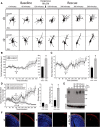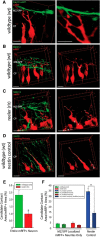Reelin Prevents Apical Neurite Retraction during Terminal Translocation and Dendrite Initiation
- PMID: 26224852
- PMCID: PMC4518046
- DOI: 10.1523/JNEUROSCI.1629-15.2015
Reelin Prevents Apical Neurite Retraction during Terminal Translocation and Dendrite Initiation
Abstract
The mechanisms controlling cortical dendrite initiation and targeting are poorly understood. Multiphoton imaging of developing mouse cortex reveals that apical dendrites emerge by direct transformation of the neuron's leading process during the terminal phase of neuronal migration. During this ∼110 min period, the dendritic arbor increases ∼2.5-fold in size and migration arrest occurs below the first stable branch point in the developing arbor. This dendritic outgrowth is triggered at the time of leading process contact with the marginal zone (MZ) and occurs primarily by neurite extension into the extracellular matrix of the MZ. In reeler cortices that lack the secreted glycoprotein Reelin, a subset of neurons completed migration but then retracted and reorganized their arbor in a tangential direction away from the MZ soon after migration arrest. For these reeler neurons, the tangential oriented primary neurites were longer lived than the radially oriented primary neurites, whereas the opposite was true of wild-type (WT) neurons. Application of Reelin protein to reeler cortices destabilized tangential neurites while stabilizing radial neurites and stimulating dendritic growth in the MZ. Therefore, Reelin functions as part of a polarity signaling system that links dendritogenesis in the MZ with cellular positioning and cortical lamination.
Significance statement: Whether the apical dendrite emerges by transformation of the leading process of the migrating neuron or emerges de novo after migration is completed is unclear. Similarly, it is not clear whether the secreted glycoprotein Reelin controls migration and dendritic growth as related or separate processes. Here, multiphoton microscopy reveals the direct transformation of the leading process into the apical dendrite. This transformation is coupled to the successful completion of migration and neuronal soma arrest occurs below the first stable branch point of the nascent dendrite. Deficiency in Reelin causes the forming dendrite to avoid its normal target area and branch aberrantly, leading to improper cellular positioning. Therefore, this study links Reelin-dependent dendritogenesis with migration arrest and cortical lamination.
Keywords: dendritogenesis; lissencephaly; mental retardation; polarity.
Copyright © 2015 O'Dell et al.
Figures






Similar articles
-
Layer 6 cortical neurons require Reelin-Dab1 signaling for cellular orientation, Golgi deployment, and directed neurite growth into the marginal zone.Neural Dev. 2012 Jul 7;7:25. doi: 10.1186/1749-8104-7-25. Neural Dev. 2012. PMID: 22770513 Free PMC article.
-
Reelin and the Cdc42/Rac1 guanine nucleotide exchange factor αPIX/Arhgef6 promote dendritic Golgi translocation in hippocampal neurons.Eur J Neurosci. 2013 May;37(9):1404-12. doi: 10.1111/ejn.12153. Epub 2013 Feb 13. Eur J Neurosci. 2013. PMID: 23406282
-
GRASPs link Reelin to the Golgi during neocortical development to control neuronal migration and dendritogenesis.Commun Biol. 2025 Apr 6;8(1):572. doi: 10.1038/s42003-025-08014-x. Commun Biol. 2025. PMID: 40188221 Free PMC article.
-
Reelin, neuronal polarity and process orientation of cortical neurons.Neuroscience. 2014 Jun 6;269:102-11. doi: 10.1016/j.neuroscience.2014.03.004. Epub 2014 Mar 20. Neuroscience. 2014. PMID: 24657457 Review.
-
Role of Reelin in the development and maintenance of cortical lamination.J Neural Transm (Vienna). 2009 Nov;116(11):1451-5. doi: 10.1007/s00702-009-0228-7. Epub 2009 Apr 25. J Neural Transm (Vienna). 2009. PMID: 19396394 Review.
Cited by
-
Schizophrenia patient-derived olfactory neurosphere-derived cells do not respond to extracellular reelin.NPJ Schizophr. 2016 Aug 17;2:16027. doi: 10.1038/npjschz.2016.27. eCollection 2016. NPJ Schizophr. 2016. PMID: 27602387 Free PMC article.
-
New Insights into Reelin-Mediated Signaling Pathways.Front Cell Neurosci. 2016 May 9;10:122. doi: 10.3389/fncel.2016.00122. eCollection 2016. Front Cell Neurosci. 2016. PMID: 27242434 Free PMC article. Review.
-
Ethanol Exposure Transiently Elevates but Persistently Inhibits Tyrosine Kinase Activity and Impairs the Growth of the Nascent Apical Dendrite.Mol Neurobiol. 2019 Aug;56(8):5749-5762. doi: 10.1007/s12035-019-1473-x. Epub 2019 Jan 23. Mol Neurobiol. 2019. PMID: 30674037 Free PMC article.
-
Calcium Signaling during Cortical Apical Dendrite Initiation: A Role for Cajal-Retzius Neurons.Int J Mol Sci. 2023 Aug 19;24(16):12965. doi: 10.3390/ijms241612965. Int J Mol Sci. 2023. PMID: 37629145 Free PMC article.
-
Considering the Role of Extracellular Matrix Molecules, in Particular Reelin, in Granule Cell Dispersion Related to Temporal Lobe Epilepsy.Front Cell Dev Biol. 2022 Jun 6;10:917575. doi: 10.3389/fcell.2022.917575. eCollection 2022. Front Cell Dev Biol. 2022. PMID: 35733853 Free PMC article. Review.
References
-
- Caviness VS., Jr Neocortical histogenesis in normal and reeler mice: a developmental study based upon [3H]thymidine autoradiography. Brain Res. 1982;256:293–302. - PubMed
Publication types
MeSH terms
Substances
Grants and funding
LinkOut - more resources
Full Text Sources
Molecular Biology Databases
Miscellaneous
